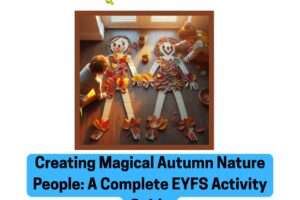
Integrating Sensory Activities In The Classroom
Integrating Sensory Activities to Improve Children’s Focus
In a swiftly evolving educational landscape, teachers continually explore innovative strategies to enhance student learning. One such approach that has gained considerable attention is the integration of sensory activities. This practice, rooted in neuroscience, can significantly impact focus, comprehension, and retention among learners of all ages. The sensory activities approach leverages the five primary senses—touch, sight, taste, smell, and hearing—along with the lesser-known stereognostic, proprioceptive (body positioning) and vestibular (balance and spatial orientation) systems. If you can create a learning environment that engages all these senses, it can help students stay focused, understand complex ideas, and encode information more robustly.

Whole Body Learning
Whole-body learning is an exciting way to teach that gets little ones moving and having fun! By incorporating physical activities into lessons, we can help young children learn better and stay engaged. This approach is especially great for stimulating their vestibular and proprioceptive systems, which are all about balance, movement, and knowing where their bodies are in space.
In mathematics, imagine turning the classroom into a big, interactive playground. For example, when learning about numbers, children can hop along a giant number line on the floor. If they’re solving simple addition problems, they can jump forward for each number they add. This playful activity not only makes math fun but also helps them understand numbers in a physical and memorable way.
In language arts, we can introduce a magical game called “Vocabulary Treasure Hunt.” Children can search for hidden word cards around the classroom and then act out the words they find. If the word is “jump,” they jump up and down; if it’s “whisper,” they use their quietest voices. This game turns learning new words into an exciting adventure that helps them remember new vocabulary through movement and play.
Tactile Learning
Tactile or touch-based activities can support self-regulation and focus in students. These activities are particularly beneficial for students with attention deficit disorder or sensory processing challenges, but they can enhance the learning experience for all students.
Teachers can use therapy putty, fidget toys, or textured materials during instructional time. These tools give students something to manipulate with their hands, providing a soothing sensory input that can help them focus better on the lesson at hand.
For older students, tactile input can also support comprehension. While assessing primary sources or diagrams, students can trace over raised diagrams or textures, helping them understand and remember the content.
Visual Variety: Stimulating Interest and Engagement
Visual variety in the classroom can keep students engaged and interested in the learning material. Changing up materials and visual aids, such as anchor charts, frequently can help maintain this interest.
Interactive whiteboards are a powerful tool for visually stimulating lessons. Teachers can display current concepts on the board, and students can annotate or interact remotely. This interactive learning experience can significantly enhance comprehension and retention.
Incorporating outdoor elements, such as chalkboards, can also break up screen time and provide a refreshing change of scenery. This can help reduce screen fatigue and re-energize students for learning.
Learning Environment: Optimising the Physical Space
The physical environment of a classroom can significantly impact students’ focus and learning. A clutter-free, well-lit, and quiet environment can optimize alertness and concentration.
Teachers can engineer light levels using Spectra floor lamps or dimmer switches. Adjusting the lighting to a level that’s comfortable for students can prevent eye strain and improve focus.
Background noise machines can mask distractions in the classroom, providing a constant, soothing sound that can enhance concentration. Similarly, personal listening stations can allow students to control their auditory environment, giving them the flexibility to focus on their work without being disturbed by classroom noise.
Multisensory Reinforcement: Engaging Multiple Senses To Improve Memory
Combining multiple sensory inputs can result in robust information encoding into long-term memory. When students engage multiple senses in the learning process, they are more likely to remember and understand the material.
Common hands-on activities for lessons include teaching fractions by having students cut and taste pies. This activity engages the senses of touch, sight, and taste, making the concept of fractions tangible and memorable. Science hypotheses could also be explored through taste and recording. For example, students could taste different foods or liquids as part of a science experiment and record their observations, engaging multiple senses and reinforcing the scientific method.
Assessing the Impact of Sensory Strategies
Effective monitoring of students’ progress is integral to evaluating the impact of sensory strategies employed. A range of formal and informal assessment methods can provide teachers with insightful data to inform differentiated instruction.
Baseline assessment involves noting target skills and behaviours prior to strategy implementation. Educators should observe indicators such as engagement, attention span and work completion rate. Supplementary tools like rating scales can capture students’ self-assessment of factors like perceived stress levels and focus.
Once techniques are integrated, ongoing observational assessment examines the degree and duration of skills demonstrated across subject areas. Teachers make observational notes regarding markers of regulation, participation and academic performance in lessons incorporating relevant strategies.
Comparative data analysis reviews information gathered before and after changes to sensory support. Progress trackers chart measurable shifts in negatively impacting and replacement behaviours over time. Graphing quantitative results indicates trend lines and the efficacy of tailored accommodations.
Student voice provides valuable perspective via methods such as interviews, surveys and learner-led conference components. Portfolios allow reflection on personal progress and advocate for evolving needs. Parent-teacher meetings facilitate information sharing across environments.
A multi-modal approach to progress monitoring creates a comprehensive overview of the multi-faceted outcomes sensory integration aims to foster. Both soft skills and harder outcome measures feature in a balanced assessment framework. Ongoing evaluation ensures a responsive, evidence-based and inclusive learning experience for all students.
Additional Sensory-Inclusive Classroom Resources:
- The Out-of-Sync Child by Carol Stock Kranowitz – Gold-standard book addressing sensory processing
- Fidget toys like tangles, stress balls, stretchy bands – Stock a calm-down station
- Theraputty
- Binaural Beats Study Music playlists on YouTube
Sensory Activities to Improve Focus FAQ
Q: How will I know which activities will work best for each child?
A: Take time to observe students individually and note things like their reactions to different classroom stimuli, preferred activities during free time, etc. You can also try various activities and see which ones lead to improved attention and participation during lessons. Working with parents, therapists and other support staff can provide additional insight into each child’s needs.
Q: What if an activity is too distracting for a student?
A: Start with lower stimulation activities and short periods of engagement to see how students respond. Be prepared to adapt the activity in the moment if you notice off-task behaviour increasing. You can also try the activity in a quiet area away from peers at first. Keep activities engaging but not overstimulating. It’s a process of finding each child’s optimal activation zone.
Q: How do I fit these into an already-packed schedule?
A: Look for natural connections you can leverage like incorporating movement during transition times between subjects. You can also replace less productive activities with sensory ones. Be selective – you don’t need every lesson to include multiple activities. Even a 2-3 minute break with stretches or fidgets can help reset focus. Consistency is key.
Q: What if students see these as “fun time” rather than learning time?
A: Establish clear expectations that the sensory activities are to support their focus, participation and comprehension, not entertainment breaks. Incorporate explicit learning targets throughout and guide students in identifying how the activities are helping them learn. Positive reinforcement for on-task behaviour during activities can also help reinforce the intended purpose.
Q: How do I get SLT on board with these changes?
A: Emphasise the research backing sensory integration strategies and the impact on academic engagement. Offer to track data on focus/participation before and after implementation. Highlight how it supports all learning styles and can be done with limited budget impact. Ask for a trial period and be prepared to share positive results. In most schools, leadership typically comes to support effective methods.
Conclusion
In conclusion, integrating sensory activities into the classroom can significantly enhance the learning experience for students. By engaging the vestibular and proprioceptive systems through whole-body learning, students are able to better understand and retain information. Tactile inputs provide soothing sensations that support self-regulation and increase focus, while visual variety keeps students engaged and interested in the learning material. A well-designed environment, free of clutter and engineered with optimal light and sound levels, can further enhance focus and alertness. Multisensory reinforcement, which engages multiple senses, can lead to robust encoding of information, resulting in improved comprehension and memory. Lastly, monitoring progress and adjusting techniques based on observational data ensures that all learners can reach their maximum potential. As educators, it is our responsibility to provide our students with the best possible environment for learning, and sensory activities offer a proven and effective way to do so.
Related
Discover more from Special Education and Inclusive Learning
Subscribe to get the latest posts sent to your email.
Source link



